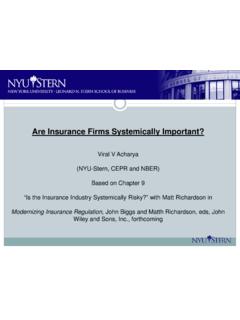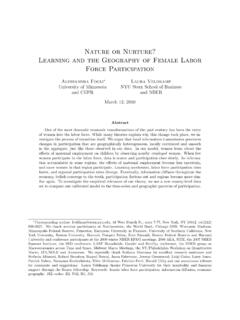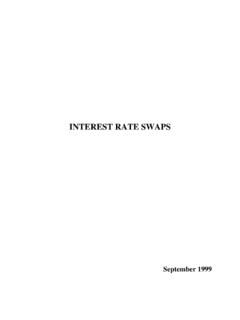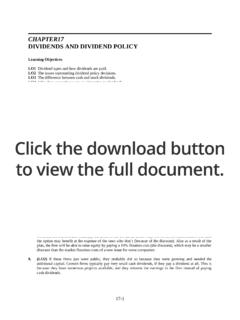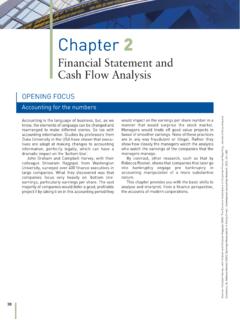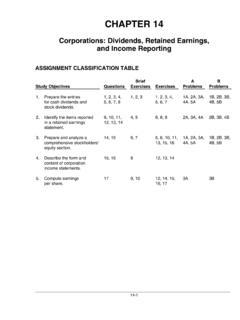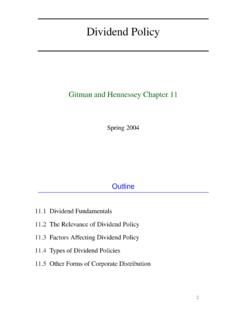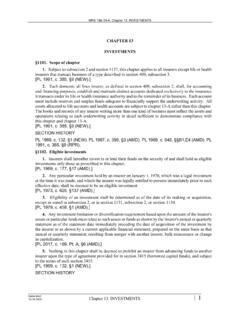Transcription of CHAPTER 13 DIVIDEND DISCOUNT MODELS
1 1. CHAPTER 13. DIVIDEND DISCOUNT MODELS . In the strictest sense, the only cash flow you receive from a firm when you buy publicly traded stock is the DIVIDEND . The simplest model for valuing equity is the DIVIDEND DISCOUNT model -- the value of a stock is the present value of expected dividends on it. While many analysts have turned away from the DIVIDEND DISCOUNT model and viewed it as outmoded, much of the intuition that drives discounted cash flow valuation is embedded in the model. In fact, there are specific companies where the DIVIDEND DISCOUNT model remains a useful took for estimating value. This CHAPTER explores the general model as well as specific versions of it tailored for different assumptions about future growth. It also examines issues in using the DIVIDEND DISCOUNT model and the results of studies that have looked at its efficacy. The General Model When an investor buys stock, she generally expects to get two types of cashflows - dividends during the period she holds the stock and an expected price at the end of the holding period.
2 Since this expected price is itself determined by future dividends, the value of a stock is the present value of dividends through infinity. t = . E(DPSt ). Value per share of stock = (1 + k ) t t =1 e where, DPS t = Expected dividends per share ke = Cost of equity The rationale for the model lies in the present value rule - the value of any asset is the present value of expected future cash flows discounted at a rate appropriate to the riskiness of the cash flows. There are two basic inputs to the model - expected dividends and the cost on equity. To obtain the expected dividends, we make assumptions about expected future growth rates in earnings and payout ratios. The required rate of return on a stock is determined by its riskiness, measured differently in different MODELS - the market beta in the CAPM, and the factor betas in the arbitrage and multi-factor MODELS . The model is flexible enough to allow for time-varying DISCOUNT rates, where the time variation is caused by expected changes in interest rates or risk across time.
3 Versions of the model 2. Since projections of dollar dividends cannot be made through infinity, several versions of the DIVIDEND DISCOUNT model have been developed based upon different assumptions about future growth. We will begin with the simplest a model designed to value stock in a stable-growth firm that pays out what it can afford in dividends and then look at how the model can be adapted to value companies in high growth that may be paying little or no dividends. I. The Gordon Growth Model The Gordon growth model can be used to value a firm that is in 'steady state' with dividends growing at a rate that can be sustained forever. The Model The Gordon growth model relates the value of a stock to its expected dividends in the next time period, the cost of equity and the expected growth rate in dividends. DPS1. Value of Stock =. ke g where, DPS 1 = Expected Dividends one year from now (next period). ke= Required rate of return for equity investors g = Growth rate in dividends forever What is a stable growth rate?
4 While the Gordon growth model is a simple and powerful approach to valuing equity, its use is limited to firms that are growing at a stable rate. There are two insights worth keeping in mind when estimating a 'stable' growth rate. First, since the growth rate in the firm's dividends is expected to last forever, the firm's other measures of performance (including earnings) can also be expected to grow at the same rate. To see why, consider the consequences in the long term of a firm whose earnings grow 6% a year forever, while its dividends grow at 8%. Over time, the dividends will exceed earnings. On the other hand, if a firm's earnings grow at a faster rate than dividends in the long term, the payout ratio, in the long term, will converge towards zero, which is also not a steady state. Thus, though the model's requirement is for the expected growth rate in dividends, analysts should be able to substitute in the expected growth rate in earnings and get precisely the same result, if the firm is truly in steady state.
5 The second issue relates to what growth rate is reasonable as a 'stable' growth rate. As noted in CHAPTER 12, this growth rate has to be less than or equal to the growth rate of the economy in which the firm operates. This does not, however, imply that analysts will always 3. agree about what this rate should be even if they agree that a firm is a stable growth firm for three reasons. Given the uncertainty associated with estimates of expected inflation and real growth in the economy, there can be differences in the benchmark growth rate used by different analysts, , analysts with higher expectations of inflation in the long term may project a nominal growth rate in the economy that is higher. The growth rate of a company may not be greater than that of the economy but it can be less. Firms can becomes smaller over time relative to the economy. There is another instance in which an analyst may be stray from a strict limit imposed on the 'stable growth rate'. If a firm is likely to maintain a few years of 'above-stable' growth rates, an approximate value for the firm can be obtained by adding a premium to the stable growth rate, to reflect the above-average growth in the initial years.
6 Even in this case, the flexibility that the analyst has is limited. The sensitivity of the model to growth implies that the stable growth rate cannot be more than 1% or 2% above the growth rate in the economy. If the deviation becomes larger, the analyst will be better served using a two-stage or a three-stage model to capture the 'super-normal' or 'above-average' growth and restricting the Gordon growth model to when the firm becomes truly stable. Does a stable growth rate have to be constant over time? The assumption that the growth rate in dividends has to be constant over time is a difficult assumption to meet, especially given the volatility of earnings. If a firm has an average growth rate that is close to a stable growth rate, the model can be used with little real effect on value. Thus, a cyclical firm that can be expected to have year-to-year swings in growth rates, but has an average growth rate that is 5%, can be valued using the Gordon growth model, without a significant loss of generality.
7 There are two reasons for this result. First, since dividends are smoothed even when earnings are volatile, they are less likely to be affected by year-to-year changes in earnings growth. Second, the mathematical effects of using an average growth rate rather than a constant growth rate are small. Limitations of the model The Gordon growth model is a simple and convenient way of valuing stocks but it is extremely sensitive to the inputs for the growth rate. Used incorrectly, it can yield misleading or even absurd results, since, as the growth rate converges on the DISCOUNT rate, the value goes to infinity. Consider a stock, with an expected DIVIDEND per share next period of $ , a cost of equity of 15%, and an expected growth rate of 5% forever. The value of this stock is: 4. Value = = $ - Note, however, the sensitivity of this value to estimates of the growth rate in Figure Figure : Value Per Share and Expected Growth Rate $ $ $ $ $ $ $ 0% 1% 2% 3% 4% 5% 6% 7% 8% 9% 10% 11% 12% 13% 14%.
8 As the growth rate approaches the cost of equity, the value per share approaches infinity. If the growth rate exceeds the cost of equity, the value per share becomes negative. This issue is tied to the question of what comprises a stable growth rate. If an analyst follows the constraints discussed in the previous CHAPTER in estimating stable growth rates, this will never happen. In this example, for instance, an analyst who uses a 14%. growth rate and obtains a $250 value would have been violating a basic rule on what comprises stable growth. Works best for: In summary, the Gordon growth model is best suited for firms growing at a rate comparable to or lower than the nominal growth in the economy and which have well established DIVIDEND payout policies that they intend to continue into the future. The DIVIDEND payout of the firm has to be consistent with the assumption of stability, since stable 5. firms generally pay substantial dividends1. In particular, this model will under estimate the value of the stock in firms that consistently pay out less than they can afford and accumulate cash in the process.
9 : This spreadsheet allows you to value a stable growth firm, with stable firm characteristics (beta and retun on equity) and dividends that roughly match cash flows. Illustration : Value a regulated firm: Consolidated Edison in May 2001. Consolidated Edison is the electric utility that supplies power to homes and businesses in New York and its environs. It is a monopoly whose prices and profits are regulated by the State of New York. Rationale for using the model The firm is in stable growth; based upon size and the area that it serves. Its rates are also regulated. It is unlikely that the regulators will allow profits to grow at extraordinary rates. The firm is in a stable business and regulation is likely to restrict expansion into new businesses. The firm is in stable leverage. The firm pays out dividends that are roughly equal to FCFE. Average Annual FCFE between 1996 and 2000 = $551 million Average Annual Dividends between 1996 and 2000 = $506 million Dividends as % of FCFE = Background Information Earnings per share in 2000 = $ DIVIDEND Payout Ratio in 1994 = Dividends per share in 2000 = $ Return on equity = Estimates We first estimate the cost of equity, using a bottom-up levered beta for electric utilities of , a riskfree rate of and a market risk premium of 4%.
10 Con Ed Beta = Cost of Equity = + *4% = 9%. We estimate the expected growth rate from fundamentals. Expected growth rate = (1- Payout ratio) Return on equity = ( )( ) = 1 The average payout ratio for large stable firms in the United States is about 60%. 6. Valuation We now use the Gordon growth model to value the equity per share at Con Ed: Expected dividends next year Cost of equity - Expected growth rate Value of Equity =. =. ($ )( ) = $ Con Ed was trading for $ on the day of this analysis (May 14, 2001). Based upon this valuation, the stock would have been under valued.. : This spreadsheet allows you to value a stable growth firm, with stable firm characteristics (beta and return on equity) and dividends that roughly match cash flows. Implied Growth Rate Our value for Con Ed is different from the market price and this is likely to be the case with almost any company that you value. There are three possible explanations for this deviation. One is that you are right and the market is wrong.



